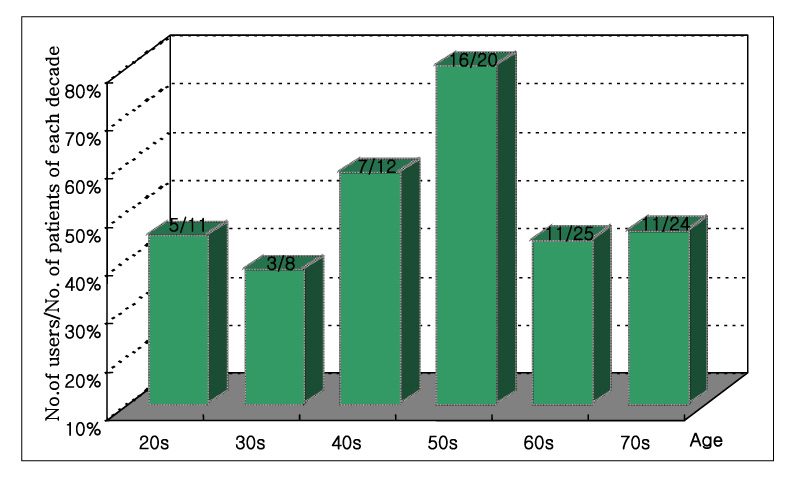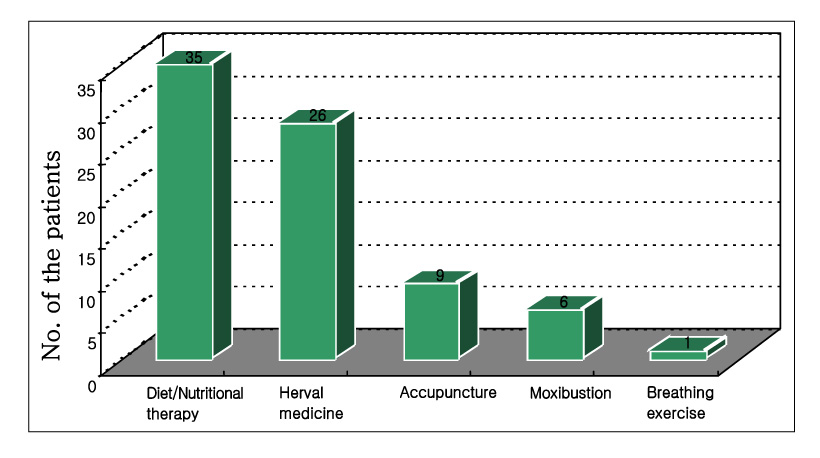Tuberc Respir Dis.
2006 Oct;61(4):339-346.
The Current Status of Complementary-Alternative Medicine for Asthmatics in Korea: Experience in One Tertiary Care Hospital
- Affiliations
-
- 1Division of Pulmonology, Kyung Hee University College of Medicine, Korea. mjpwis@chol.com
- 2Division of Pulmonology, East-West Neomedical Center, Korea.
Abstract
-
BACKGROUND: There has no known epidemiologic survey on the frequency of complementary-alternative medicine (CAM) use in the treatment of adult asthma in Korea. This study examined the current use of CAM by asthma patients in Korea.
METHODS
One hundred adults with asthma, who had been admitted to Kyunghee university hospital between January 2000 and December 2003, were enrolled in this survey. They received a structured questionnaire interview and a clinical assessment of prevalence and pattern of CAM use.
RESULTS
53% patients had an experience of at least one type of CAM during their asthma management. Users of CAM had more hospital visits than those who had never used CAM(1.46+/-0.68 vs. 2.11+/-1.20, p=0.001). Those in their 50th decades had more experience of CAM (80%) than the other age groups. The methods of CAM used by our patients are as follows: Diet/nutritional therapy in 35 patients(69%), herbal therapy in 28 patients(53%), acupuncture in 9 patients(17%), moxa treatment in 6 patients(11%), breathing exercises in 1 patient(2%).
CONCLUSIONS
More than 50% of patients with bronchial asthma have used CAM. A more detailed and large scaled study will be needed to define the actual status of the use of CAM in the treatment for asthma. Inaddition, further research on the scientific validation of the clinical efficacy of CAM in asthma management should be followed.
MeSH Terms
Figure
Reference
-
1. National Heart, Lung and Blood Institute/World Health Organization. National Heart, Lung and Blood Institute/ World Health Organization workshop report: Global Strategy for Asthma Management and Prevention (revised 2003). Avail from: urlhttp://www.ginasthma.com.2. Ng TP, Wong ML, Hong CY, Koh KT, Goh LG. The use of complementary and alternative medicine by asthma patients. QJM. 2003. 96:747–754.3. Ziment I, Tashkin DP. Alternative medicine for allergy and asthma. J Allergy Clin Immunol. 2000. 106:603–614.4. Blank PD, Trupin L, Earnest G, Katz PP, Yelin EH, Eisner MD. Alternative therapies among adults with a reported diagnosis of asthma or rhinosinusitis: data from a population-based survey. Chest. 2001. 120:1461–1467.5. Ernst E. Complementary therapies for asthma: what patients use. J Asthma. 1998. 35:667–671.6. Schafer T, Riehle A, Wichmann HE, Ring J. Alternative medicine in allergies: prevalence, pattern of use, and costs. Allergy. 2002. 57:694–700.7. McCarney RW, Brinkhaus B, Lasserson TJ. Acupuncture for chronic asthma. Cochrane Database Syst Rev. 2004. (1):CD000008.8. Holloway E, Ram FS. Breathing exercises for asthma. Cochrane Database Syst Rev. 2004. (1):CD001277.9. Lai X, Li Y, Fan Z, Zhang J, Liu B. An analysis of therapeutic effect of drug acupoint application in 209 cases of allergic asthma. J Tradit Chin Med. 2001. 21:122–126.10. Graham DM, Blaiss MS. Complementary/alternative medicine in the treatment of asthma. Ann Allergy Asthma Immunol. 2000. 85:438–447.11. Camargo CA Jr, Richardson LD. Brenner BF, editor. Epidemiology of asthma. Emergency asthma. 1999. New York: Marcel Dekker;59–80.12. Ninan TK, Rusell G. Respiratory symptoms and atopy in Aberdeen school children: evidence from two surveys 25 years apart. BMJ. 1992. 304:873–875.13. Korean Institute for Health and Social Affairs. Prevalence of asthma study group in Korea. Korean J Med. 2001. 60:196–205.14. Lee HB. Alternative and complement therapies for asthma. Pediatr Allergy Respir Dis. 2002. 12:247–252.15. Vincent C, Furnham A. Why do patients turn to complementary medicine?: an empirical study. Br J Clin Psychol. 1996. 35:37–48.16. Astin JA. Why patients use alternative medicine: results of a national study. JAMA. 1998. 279:1548–1553.17. Gyorik SA, Brutsche MH. Complementary and alternative medicine for bronchial asthma: is there new evidence. Curr Opin Pulm Med. 2004. 10:37–43.18. Martin J, Donaldson AN, Villarroel R, Parmar MK, Ernst E, Higginson IJ. Efficacy of acupuncture in asthma: systematic review and meta-analysis of published data from 11 randomised controlled trials. Eur Respir J. 2002. 20:846–852.19. Shapira MY, Berkman N, Ben-David G, Avital A, Bardach E, Breuer R. Short-term acupuncture therapy is of no benefit in patients with moderate persistent asthma. Chest. 2002. 121:1396–1400.20. Huntley A, Ernst E. Herbal medicines for asthma: a systematic review. Thorax. 2000. 55:925–929.21. Linde K, Clausius N, Ramirez G, Melchart D, Eitel F, Hedges LV, et al. Are the clinical effects of homeopathy placebo effects?: a meta-analysis of placebocontrolled trials. Lancet. 1997. 350:834–843.22. Blanc PD, Kuschner WG, Katz PP, Smith S, Yelin EH. Use of herbal products, coffee or black tea, and over-the-counter medications as self-treatments among adults with asthma. J Allergy Clin Immunol. 1997. 100:789–791.23. Schafer T. Epidemiology of complementary alternative medicine for asthma and allergy in Europe and Germany. Ann Allergy Asthma Immunol. 2004. 93:S5–S10.24. Sommer JH, Burgi M, Theiss R. A randomized experiment of the effects of including alternative medicine in the mandatory benefit package of health insurance funds in Switzerland. Complement Ther Med. 1999. 7:54–61.
- Full Text Links
- Actions
-
Cited
- CITED
-
- Close
- Share
- Similar articles
-
- Health Status and the Use of Complementary and Alternative Therapies in the Community Dwelling Pre-elderly and Elderly
- The Contributing Factors to Utilize Complementary and Alternative Medicine in People with Epilepsy
- Complementary Medicine in Gynecology
- Status Epilepticus and Beyond: A Clinical Review of Status Epilepticus and an Update on Current Management Strategies in Super-refractory Status Epilepticus
- Knowledge and Attitude about Alternative Treatment in Cancer Patient



